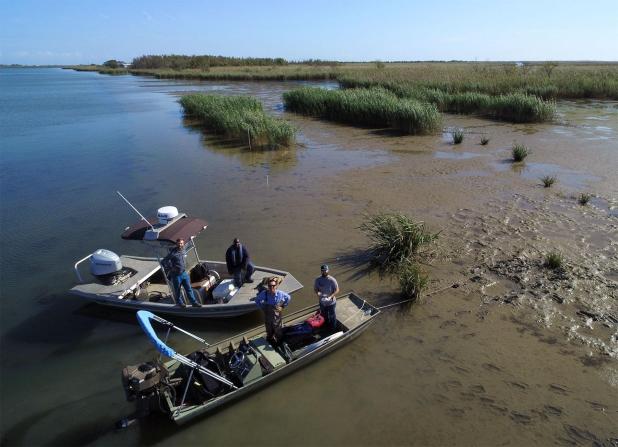
LSU AgCener/Joshua Snook
Members of LSU AgCenter entomologist Rodrigo Diaz’s lab getting ready to plant roseau cane.
$1.6M grant will help ag team tackle die-back phenomenon
A multidisciplinary team of researchers recently received a $1.6 million award from the United States Department of Agriculture Animal and Plant Health Inspection Service to support a variety of projects centering on the troubling phenomenon of roseau cane die-back.
The grant, titled “Roseau Cane Die-Back: Integrating Across Disciplines, Long-Term Monitoring and Public Access to Findings,” focuses on roseau cane (Phragmites australis) decline in the Mississippi River Delta.
“Roseau cane is the dominant vegetation at the Bird’s Foot Delta of the Mississippi River,” said Rodrigo Diaz, AgCenter entomologist and lead researcher on the project. “Stands of cane protect oil infrastructure and navigation channels while providing habitat for wildlife, and massive areas have been dying since 2016.”
The research involves 11 projects focused on the Mississippi River Delta, the first of which explores the plant’s diverse chemical responses to environmental stressors. The team plans to create an open-source database to share genetic, transcriptomic and metabolomic data for various roseau cane populations.
The second project investigates the decline in roseau cane cover, attributing it to increased flooding stress and potential feedback mechanisms leading to peat collapse. The third analyzes the transcriptome of roseau cane in response to various stresses, including herbivory, microbes, salinity and flooding.
The fourth project investigates foliar fungal virulence and viral diversity in roseau cane, aiming to understand the contribution of pathogens to the plant’s decline, and the fifth focuses on developing a web platform for roseau cane monitoring in Louisiana, integrating multidisciplinary studies and utilizing remote sensing for habitat analysis.
Projects six, seven and eight explore the effects of roseau cane die-back on sedimentation, water and sediment routing as well as morphologic and vegetation dynamics, respectively, using field investigations and numerical modeling.
Project nine involves field monitoring of roseau cane health and establishment of midscale restoration plots, while projects 10 and 11 focus on biological control methods for the invasive scale and evaluating host range testing of a new parasitoid that was discovered in Louisiana.
The team met Jan. 10 at the LSU Hilltop Arboretum to share results gathered in 2023. The agenda included presentations or posters covering topics such as biotic factors, abiotic factors, remote sensing, hydrodynamics and restoration. The summit brought together more than 30 people attending from different institutions and countries.
One of the projects discussed was the outcomes of restoration trials conducted at the Pass-A-Loutre Wildlife Management Area.
Results suggested that planting stems in areas of active sediment deposition can accelerate the establishment and formation of roseau cane stands.
“Our summit was not only a venue to share the latest data among scientists, but also offered an outstanding opportunity for students to learn about multidisciplinary projects addressing ecological problems,” Diaz said.
Overall, Diaz believes these projects aim to understand the ecological dynamics and threats to roseau cane, address its decline and inform potential conservation and restoration efforts.
The funding is slated to last two years, and Diaz hopes it will lead to fruitful results due to the adverse impact of roseau cane die-back on the region.
“This funding will support projects leading us closer to understanding the die-back as well as to developing practical approaches for roseau cane restoration,” he said.
